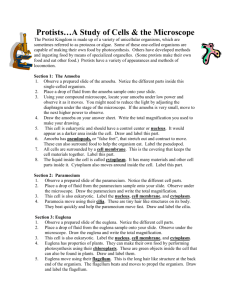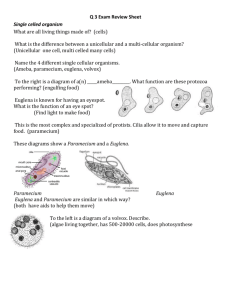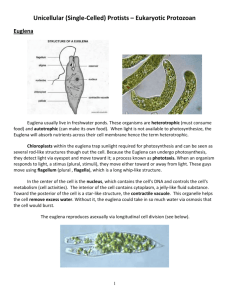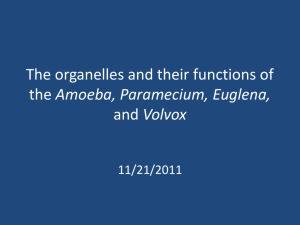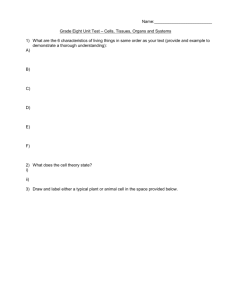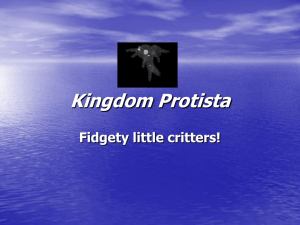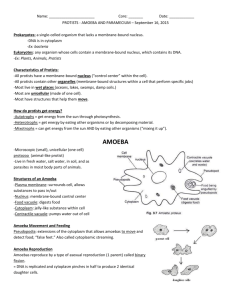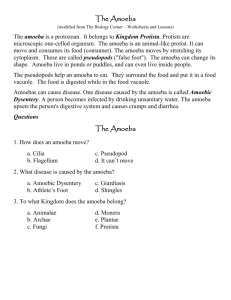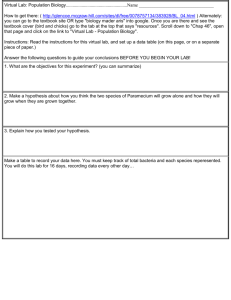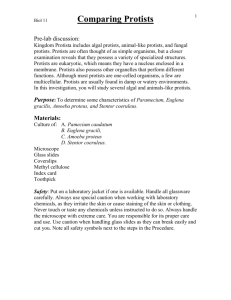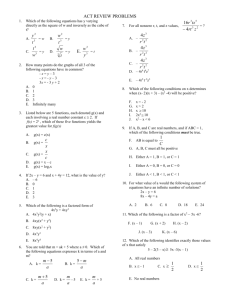Amoeba
advertisement
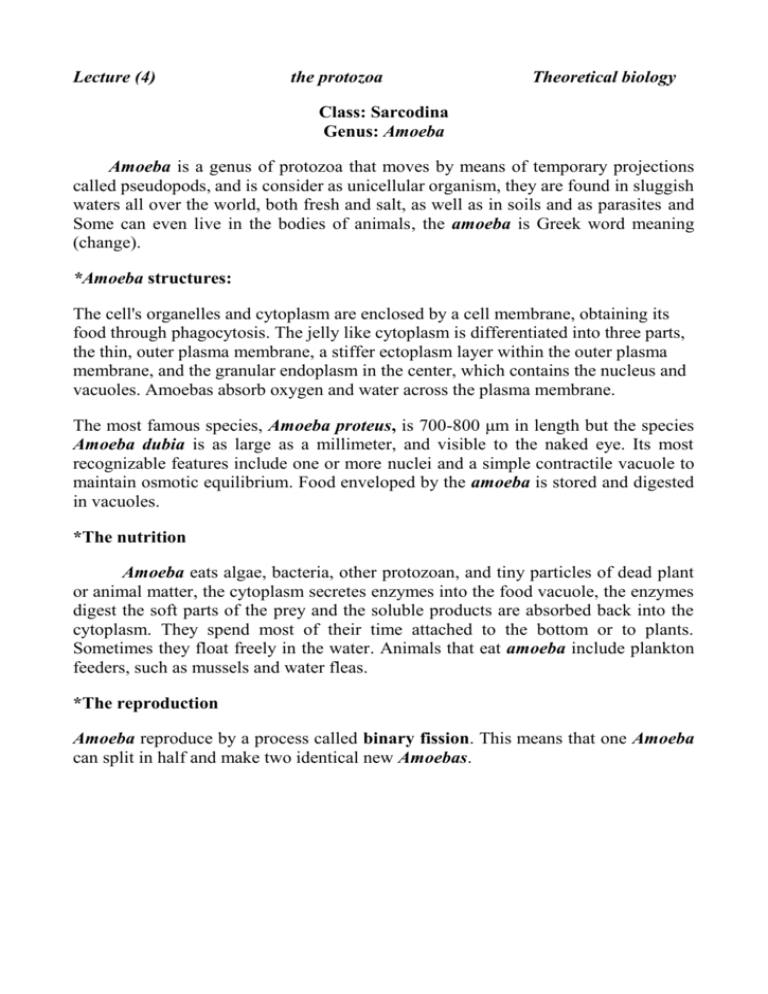
Lecture (4) the protozoa Theoretical biology Class: Sarcodina Genus: Amoeba Amoeba is a genus of protozoa that moves by means of temporary projections called pseudopods, and is consider as unicellular organism, they are found in sluggish waters all over the world, both fresh and salt, as well as in soils and as parasites and Some can even live in the bodies of animals, the amoeba is Greek word meaning (change). *Amoeba structures: The cell's organelles and cytoplasm are enclosed by a cell membrane, obtaining its food through phagocytosis. The jelly like cytoplasm is differentiated into three parts, the thin, outer plasma membrane, a stiffer ectoplasm layer within the outer plasma membrane, and the granular endoplasm in the center, which contains the nucleus and vacuoles. Amoebas absorb oxygen and water across the plasma membrane. The most famous species, Amoeba proteus, is 700-800 μm in length but the species Amoeba dubia is as large as a millimeter, and visible to the naked eye. Its most recognizable features include one or more nuclei and a simple contractile vacuole to maintain osmotic equilibrium. Food enveloped by the amoeba is stored and digested in vacuoles. *The nutrition Amoeba eats algae, bacteria, other protozoan, and tiny particles of dead plant or animal matter, the cytoplasm secretes enzymes into the food vacuole, the enzymes digest the soft parts of the prey and the soluble products are absorbed back into the cytoplasm. They spend most of their time attached to the bottom or to plants. Sometimes they float freely in the water. Animals that eat amoeba include plankton feeders, such as mussels and water fleas. *The reproduction Amoeba reproduce by a process called binary fission. This means that one Amoeba can split in half and make two identical new Amoebas. 1. Amoeba stops moving and rounds off 2. The nucleus begins to divide. 3. The nucleus has divided and the cytoplasm starts to constrict. 4 & 5 the constriction continues to divide the cytoplasm. 6. The daughter amoeba separate. Class: Ciliate Genus: Paramecium Paramecia are a group of unicellular ciliate protozoa, and range from about 50 to 350 µm in length, depending on species. Simple cilia cover the body, which allow the cell to move. They generally feed on bacteria and other small cells. Paramecia are widespread in freshwater environments. *Structure of paramecium The paramecium approximates a prolate spheroid, rounded at the front and pointed at the back. The pellicle is a stiff but elastic membrane that gives the paramecium its definite shape. Covering the pellicle are many tiny hairs, called cilia. On the ventral side near from middle of the body contain on the oral groove then gullet, which collects food and sweep into the cell mouth. There is an opening near the back end called the anal pore, the paramecium contains cytoplasm, trichocysts, food vacuoles, a pair of contractile vacuoles( anterior and posterior ), macronucleus and micronucleus. *Paramecium - Feeding Paramecium is feed on microscopic organisms such as bacteria and single-celled algae. Amoeba is able to take in food at almost any point on its surface, but Paramecium, can take in food only at the cytostome. The cilia in the oral groove create a current of water which wafts the food organisms up to the cytostome where they are ingested in a food vacuole. This food vacuole then follows a specific route through the cytoplasm. On its travels, enzymes are secreted into the vacuole and the food is digested. The digested substances are then absorbed into the cytoplasm. Any undigested matter is expelled through the anal pore. * Reproduction of Paramecium Paramecium reproduces asexual by binary fission under ideal conditions. (1)The ciliate stops moving (2) and both macro- and micronucleus divide and move to opposite ends of the organism. (3)The cytoplasm then divides at right angles to the long axis and (4) the daughter paramecia separate.* Binary fission may take place 2 or 3 times each day. The paramecium reproduce sexually through a form of conjugation, Paramecium only reproduce sexually under stressful conditions. This occurs via gamete agglutination and fusion. Two Paramecia join together and their respective micronuclei undergo meiosis. Three of the resulting nuclei disintegrate, the fourth undergoes mitosis. Daughter nuclei fuse and the cells separate. The old macronucleus disintegrates and a new one is formed. This process is usually followed by asexual reproduction. Class: Mastigophora Genus: Euglena Euglena is unicellular organisms called phytomastigina which use flagellum as a method of locomotion. Euglena is reproducing asexually by binary fission. *Form of Euglena: Euglena is a protist that can both eat food as animals by heterotrophy; and can photosynthesize, like plants, by autotrophy. The Euglena utilizes chloroplasts, by photosynthesis. Euglena is able to move through aquatic environments by using a large flagellum for locomotion. To observe its environment, the cell contains an eyespot, a primitive organelle that filters sunlight into the light-detecting, photosensitive structures at the base of the flagellum. This photo-sensitive area detects the light that is able to be transmitted through the eyespot. When such light is detected, the Euglena may accordingly adjust its position to enhance photosynthesis. Many Euglenas are considered mixotrophs: autotrophy in sunlight and heterotrophy in the dark. Euglena also structurally lacks cell walls, but have a pellicle instead. The pellicle is made of protein bands that spiral down the length of the Euglena and lie beneath the plasma membrane. Euglena can survive in fresh and salt water. In low moisture conditions, a Euglena forms a protective wall around itself and lies dormant as a spore until environmental conditions improve. Euglena can also survive in the dark by storing paramylum granules in pyernoid bodies within the chloroplast. Class: Mastigophora Genus: Trypanosoma Trypanosoma are flagellate protozoa which live in the blood stream. There are several different species of Trypanosoma and they cause diseases such as sleeping sickness, surra and Chaga's disease and, in cattle, nagana. The sleeping sickness and nagana parasites are transmitted by the bite of the tsetse fly (Glossina Genus). This insect has tubular mouthparts, like the mosquito, and these pierce the skin to suck blood from a capillary. The trypanosoma divided into two groups depended on method transmission of the infective stage 1- Salivaria group: like T. brucei, this parasite transmitted by saliva of the tsetse fly. 2- Sterocoraria group: like T.cruzi, this parasite transmitted by faeces of bugs. Forms of the Trypanosomatidae: Amastigote - Basal body anterior of nucleus, with a short, essentially nonfunctional, flagellum. Promastigote - Basal body anterior of nucleus, with a long detached flagellum. Epimastigote - Basal body anterior of nucleus, with a long flagellum attached along the cell body. Trypomastigote - Basal body posterior of nucleus, with a long flagellum attached along the cell body. * Reproduction of Trypanosoma The Trypanosoma reproduce by binary fission: 1. The basal body replicates, both remaining associated with the kinetoplast. 2. The kinetoplast undergoes replication, and the daughter kinetoplasts are separated by the basal bodies. 3. The second flagellum grows while the nucleus undergoes replication. 4. The mitochondria divide, and cytokinesis progresses from the anterior to posterior end. 5. The division resolves. The daughter cells may stay connected for a significant length of time after cytokinesis is complete. * Infection and symptoms: The disease is mostly transmitted through the bite of an infected tsetse fly but there are other ways in which people are infected with sleeping sickness. Mother-to-child infection: the trypanosome can cross the placenta and infect the fetus. Mechanical transmission through other blood sucking. Accidental infections have occurred in laboratories due to pricks from contaminated needles. In the first stage, the trypanosomes multiply in subcutaneous tissues, blood and lymph, which cause fever, headaches, joint pains and itching. In the second stage the parasites cross the blood-brain barrier to infect the central nervous system, the signs and symptoms of the disease appear: changes of behavior, confusion, sensory disturbances and poor coordination. Disturbance of the sleep cycle, which gives the disease its name, is an important feature of the second stage of the disease. Without treatment, sleeping sickness is considered fatal. *Diagnosis 1- Trypanosomes found in blood, lymph and cerebrospinal fluid. 2- Serological tests. Class: Sporozoa Toxoplasma gondii Toxoplasmosis is a parasitic disease caused by the protozoan Toxoplasma gondii. *Definitive host: cat *Intermediate host: human and other animals (herbivores, carnivores, omnivores). * Forms of Toxoplasma gondii Oocyst The infective form of T. gondii, the oocyst is round to slightly oval. The transparent oocyst contains two sporocysts, each with four sporozoites. A clear and colorless, two-layered cell wall borders the organism. *Tachyzoites (trophozoites) The actively multiplying crescent – shaped Tachyzoites, one end of the organism often appears more rounded than the other end .each tachyzoite equipped with a single centrally located nucleus, surrounded by a cell membrane. *Bradyzoites (cyst) The typical bradyzoite basically has the same physical appearance as the tachyzoite, only smaller in size. These slow – growing, viable forms gather in clusters inside a host cell develop a surrounding membrane, and form a cyst in a variety of host tissues and muscles outside of the intestinal tract. *Life cycle The definitive host in the Toxoplasma life cycle is the cat. Upon ingestion of Toxoplasma cysts present in the brain or muscle tissue of contaminated mice or rats, the enclosed bradyzoites are released in the cat and quickly transform into tachyzoites. Both sexual and asexual reproduction occurs in the gut of the cat. The sexual cycle results in the production of immature oocysts, which are ultimately shed in the stool. The oocysts complete their maturation in the outside environment, a process that typically takes from 1 to 5 days. Rodents, particularly mice and rats, serve as the intermediate hosts, ingesting the infected mature Toxoplasma oocysts while forging for food. The sporozoites emerge from the mature oocyst and rapidly convert into actively growing tachyzoites in the intestinal epithelium of the rodent. *Signs and symptoms 1- Acute toxoplasmosis During acute toxoplasmosis, symptoms are often influenza-like: swollen lymph nodes, or muscle aches. Young children and immunocompromised patients, such as those with Acquired immune deficiency syndrome (AIDS), those taking certain types of chemotherapy, or those who have recently received an organ transplant, may develop severe toxoplasmosis. This can cause damage to the brain or the eyes. Infants infected via placental transmission may be born with either of these problems. 2- Latent toxoplasmosis Most patients who become infected with Toxoplasma gondii and develop toxoplasmosis do not know it. In most immunocompetent patients, the infection enters a latent phase, during which only bradyzoites are present, forming cysts in nervous and muscle tissue. *Diagnosis: 1- Oocyst in feces of cats. 2- Serology test. 3- Histological examination
